HOLIDAYS IN JAPAN
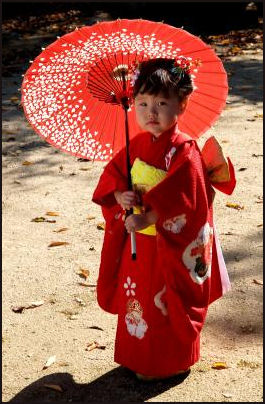
Shichi-go-san Japan has 14 national holidays, more than most countries, and these are welcome relief for salarymen who work on Saturdays and have trouble using their vacation leave. After World War II all pre-war holidays were abolished. In 1948 the Law Concerning National Holidays was enacted. It initially designated nine holidays. Since then an additional six have been added to bring the total to 15. The passage of the "Happy Monday" law in 1998, placed most of the nations holidays on Monday.
Many national holidays are based on old imperial holidays. National Foundation Day on February 11th commemorates the ascension of the legendary emperor Jimmu to the throne in the 7th century B.C. Greenery Day on April 29th, a kind of arbor day to encourage tree planting, is held on Emperor Hirohito's birthday. Culture Day on October 3rd is a national holiday held on the birthday of the Emperor Meiji. Labor-Thanksgiving Day on November 23 is held around the same date as the old imperial rite of thanksgiving.
In some places in Japan St. Patrick’s day is celebrated with great fanfare. Shibuya Ward in Tokyo hosts a parade which drew about 1,400 participants in 2010. St. Patrick parades are also held in Nagano, Okinawa, Kyoto and Kumamoto in Kyushu
Links in this Website: JAPANESE CALENDAR AND DAYLIGHT SAVINGS TIME Factsanddetails.com/Japan ; HOLIDAYS IN JAPAN Factsanddetails.com/Japan ; NEW YEAR'S IN JAPAN Factsanddetails.com/Japan ; FESTIVALS IN JAPAN Factsanddetails.com/Japan ; FUNERALS IN JAPAN Factsanddetails.com/Japan
Good Websites and Sources: Public Holidays japan-guide.com ; Wikipedia article Wikipedia ; Japanese Holiday Traditions on Focus on Japan asij.ac.jp ; Christmas in Japan tanutech.com ; Coming of Age Day in Japan dannychoo.com ; Valentine’s Day in Japan tanutech.com ; Cherry Blossoms japanvisitor.com ; Global Warming and Cherry Blossoms telegraph.co.uk ; Cherry Blossom Forecasts jnto.go.jp ; Good Photos of Cherry and Plum Blossoms at Japan-Photo Archive japan-photo.de ; Cherry Blossoms: Good places to see cherry blossoms in the Tokyo area include Ueno Park, Sumida Park (Asakura Station), Yakushina Shrine, Chidorigafuchi by the moat at the Imperial Palace, Showa Memorial Park (Nishi-Tachikawa Station), Aoyama Cemetery (Nogizaka Station) and Shinjuki Gyeon.
Milestone Celebrations in Japan
Japanese aren't that big on birthdays. Some people don't give presents or host birthday parties for their loved ones and friends. Sixty and 36 year birthdays in Japans are major milestones because of their significance in the Chinese calendar. Many older people don't know their birthdays. In the old days, New Year's Day was everyone's birthday. Old people are still given "birthday presents" on that day.
When a child reaches the age of seven days, his or her father bows before the household Shinto shrine and places on it a paper with the child's name. This informs ancestors of a the new addition to the family. Friends and relatives give gifts in the name-giving ceremony.
At the age of 32 or 33 days a child is taken to a Shinto shrine. The child's name is recorded and the child officially becomes a member of the community. At four months of age, the mother helps the child with chop sticks in the "first eating ceremony.” At the ages of three, five and seven, a child is take to a shrine and thanks is offered that the child reached these ages.
Parents and young children celebrate a holiday called “Shichi-go-san” (Seven-five-three) in which boys, 3 or 5, and girls, 3 or 7, and 3 are dressed in hakamas (male kimonos) or kimonos, bathed in incense smoke at a temple and have their picture taken. The purpose of the ritual is to bring good luck and health to children at ages when, in the old days, they were considered most vulnerable to sickness and disease. Some boys wear samurai swords and kimonos that cost $3,000.
To celebrate Shichi-go-san mothers go to the beauty parlor, fathers take the day off work, and immediate family members as well as uncles, aunts, cousins and grandparents go to a fancy restaurant for a meal with eels and sea urchins and other delicious treats. Children receive a foot-long candy stick know as a "thousand-year" candy which is supposed to ensure long life.
Coming of Age Day in Japan
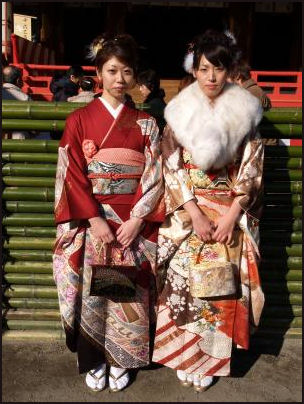
Coming-of-Age Day on January 15th is a Japanese holiday in which thousands of 20-year-olds gather at temples or assembly halls to participate in a ceremony that symbolizes reaching adulthood and leaving their childhood behind. Marking the age when young people are allowed to drink, smoke and vote, the ceremony dates back at least to the 7th century. Young women dress up colorful kimonos and fur collars and men wear black suits or traditional hakamas, long pleated skirts, and listen to speeches by local leaders and politicians and then go partying. At some Shinto shrines, barefoot young men dressed only in loin clothes pray and clap their hands in the snow. Interest in the holiday in waning.
In a traditional 500-year-old coming of age event for boys, known as “eboshigi”, which is still held at some temples, 15-year-old boys don samurai-style clothes, pour sacred sake for their elders, and prepare 31 offerings, including skewered persimmons, and white rice with red beans, for the gods. In the old days boys changed their hairstyle and were given adult names on this day.
In recent years there have been a number of incidents at Coming of Age ceremonies. In Aomori a fight broke out when one young man tried to a dance on stage and a volunteer at the event tried to stop him. After the fight stopped friends of the dancing man threatened to rush the stage and threw trash when a band appeared.
Golden Week and Vacations in Japan
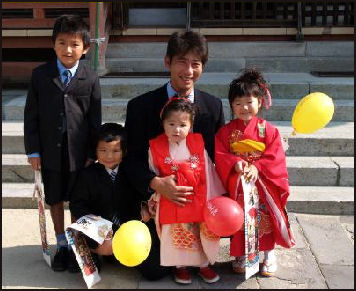
The average employee receives nearly 18 days of paid vacation. Most Japanese take vacation in August during the Bon holiday and take a week or so off before and after New Year’s Day. Another important holiday period is Golden Week, a week in late April and early May that includes Children's Day and two other major holidays. Some years, the Golden Week days off fall just right so everybody gets a week off. Other years the days are scattered in a funny way so that people take some days off, work and take a few more days off.
According to Japan's Foreign Ministry: April can be a rather stressful time for students, who are beginning a new school year, and for new company employees who typically begin work careers during this month, which corresponds with the beginning of Japan’s fiscal year. However, from the end of April, many people take from a week to ten days off work, since this period includes a cluster of national holidays, namely Showa Day on April 29, Constitution Day on May 3, Greenery Day on May 4, and Children’s Day on May 5. This period is commonly called “Golden Week.” The weather is warm and suitable for excursions, and tourist destinations throughout Japan bustle with crowds of visitors. Golden Week is notorious for traffic jams and crowded trains and airports.
Golden Week is a popular time to take domestic and international trips. On average more than 23 million Japanese take trips at that time. During the busiest days of the Golden Week transport rush the seat occupancy on some Shinkansen trains is 200 percent and the back-up ay the Kurume interchange on the Kyushu expressway is 56 kilometers.
There are plans to stagger Golden Week by region in 2012 with different parts of Japan having different days off. The idea behind the plan is to relieve congestion on Japan’s transportation network. Among those that object to the plan are people who live one area that want to visit relatives on another area, where the days of the holiday are different. Hotels and people in the tourism industry like the plan because it will extend the holiday season.
Bean Throwing Festival and Moon Viewing Party
According to the lunar calendar in use before 1873, in which the numbering of the months was about one and a half months behind that of the modern solar calendar, the coming of spring (Risshun or Setsubun) was designated as the third or fourth day of the second month. Some of the Setsubun observances that were held on this day still take place on February 3 or 4, even though this coincides with the coldest period of winter. For example, there is the ritual of opening the doors and windows of houses and expelling bad luck and evil demons by tossing beans into the air while saying “”fuku wa uchi, oni wa soto” — (“fortune in and demons out”). It is also said that one will keep healthy by eating on this day the number of beans equivalent to one’s age. This was originally an observance that took place in the imperial court on the last day of the lunar year to symbolize the sweeping away of bad spirits and winter cold and gloom, as well as to welcome the cheer of a new and bright spring. [Source: Web-Japan, Ministry of Foreign Affairs, Japan]
“Tsukimi “(Moon Viewing) According to the lunar calendar, the full moon appearing around the middle of the ninth month was called the mid-autumn moon (“chushu no meigetsu”), and it became a custom to arrange moon-viewing parties to appreciate its particular beauty. This was originally a custom practiced in China, which spread to Japan in the Heian period (794--1185). Houses were decorated with eulalia grass (“susuki”) and dumplings were made and offered to the moon together with samples of crops from the autumn harvest. Autumn “Tsukimi “During the annual “tsukimi “(moon viewing) observance, people make offerings of dumplings (“dango”) and “susuki “grass as they enjoy the full moon.
The traditional observance of Haru no Higan, or “spring “higan”,” coincides with the period of seven days centering on the spring equinox, around March 21. At this time, people visit family graves, pay their respects to the souls of their ancestors, and ask Buddhist priests to perform sutra-readings in their honor. A similar observance, known as Aki no Higan, or “autumn “higan”,” is held during the oneweek period centering on the autumnal equinox, around September 23.
Traditional Holidays for Children
Children’s Day, which falls on May 5 during Golden Week, was traditionally called Tango no Sekku (known as “Boys’ Day” in English), and was a day set aside to wish for the healthy growth and future career success of young boys. Traditional decorations were carp-shaped cloth streamers attached to poles (“koinobori”) and dolls in the guise of warriors “(mushaningyo”), while special food delicacies were rice dumplings wrapped in bamboo leaves (“chimaki”) and rice cakes wrapped in oak leaves (“kashiwamochi”). In ancient times, the fifth month of the year was considered a bad month, and the fifth day of that month was thought to be particularly inauspicious. Tango no Sekku first developed as an annual observance of ritual purification to eliminate defilement. On this day there is the custom of bathing in hot water containing iris leaves. It was traditionally thought that such leaves not only had medicinal properties but could banish evil. [Source: Web-Japan, Ministry of Foreign Affairs, Japan]
Shichigosan: November 15 is a day for visiting Shinto shrines with boys aged three and five and girls aged three and seven to pray for their safety and healthy growth. Traditionally, small boys wear haori “(Japanese half-coats) and “hakama “(divided skirts) and the girls wear kimono, but many are seen nowadays wearing suits and dresses. On this day, parents buy at shrines a type of candy called “chitose-ame “which is supposed to convey prayers for long life, and at home families celebrate by eating rice boiled with red beans (“sekihan”) and a sea bream prepared complete with head and tail (“okashiratsuki no tai”).
Hina Matsuri (Doll Festival) is celebrated on March 3, when spring is not far off. This is an annual event to pray for the happiness and healthy growth of young girls. On this day, families display “hina ningyo”, dolls dressed in traditional court apparel, along with peach blossoms and offerings of such delicacies as white saké, diamond-shaped rice cakes (“hishimochi”), and dry rice-cake pellets (“arare”) The Hina Matsuri observance derives from ancient beliefs about ritual purification. At one time it was believed that human misdeeds and defilements could be washed away and purified in rites held beside streams. Later, dolls made of paper were used in these rituals, and after the Edo period (1600--1868) these dolls began to be designed in the form of the “hina ningyo “seen today.
Tanabata and Summer Firworks
The first annual observance of summer is known as Tanabata, falling on July 7. It is a day that commemorates a romantic story, first handed down to Japan’s imperial court via China and Korea and then becoming popular among the common people, about the oncea- year meeting on a bridge across the Milky Way of the “cowherd star” and the “weaving princess star.” It was believed that wishes made on this day would be fulfilled; in gardens and other places people set up leafbearing bamboo stalks to whose branches they attached strips of paper on which their wishes were written. Summer Tanabata On July 7, people write their wishes on narrow strips of paper and decorate them with bamboo grass for the Tanabata festival. [Source: Web-Japan, Ministry of Foreign Affairs, Japan]
Today, Tanabata festivals are celebrated at numerous places around Japan. Some of the best-known take place at the Kitano Tenmangu Shrine in Kyoto, the Konpira Shrine in Kagawa Prefecture, and in the cities of Hiratsuka in Kanagawa Prefecture and Takaoka in Toyama Prefecture. Also well known is the Sendai Tanabata festival in Miyagi Prefecture, which takes place a month later on August 7, closer to the time of year when Tanabata was earlier observed by the lunar calendar.
Throughout Japan, night skies in summer are lit by colorful fireworks as various localities put on fireworks displays (“hanabi taikai”). Japan’s fireworks technology is said to be the world’s best and has been handed down from generation to generation since the Edo period. Today’s fireworks displays are often controlled by computers to enhance their precision and spectacular visual effects. In Tokyo, fireworks displays along the Sumida River have been famous annual events since the Edo period.
“Bonenkai “(Year-End Parties)
After the beginning of December, many yearend parties known as “bonenkai “take place in pubs and restaurants. These are motivated both by the idea of expressing appreciation for people’s hard work during the year and the notion of forgetting difficulties, and having a good time at the year’s end. People of all ages and belonging to all kinds of groups, including students and company employees, become busy planning these events. In most cases, each participant pays his or her own expenses, but there are cases where companies sponsor “bonenkai “for their employees and cover these parties’ costs. [Source: Web-Japan, Ministry of Foreign Affairs, Japan]
Christmas In Japan, Christmas has become popular as a seasonal occasion and, whether or not they are Christians, the Japanese people are fond of displaying Christmas trees, eating Christmas cakes, and exchanging Christmas presents. It is an especially exciting time for children, who await the bringing of gifts by Santa Claus while they sleep.
Winter New Year’s Eve bells New Year’s Eve When Christmas has passed and the “bonenkai “are over, it will soon be December 31, called in Japanese “omisoka”. Just before midnight, Buddhist temples all over the country begin to strike bells in an observance known as “joya no kane”. The bells are struck 108 times, symbolizing a purification of what are said to be 108 earthly desires (“bonno”). Then a new year will begin with the observance of Shogatsu
Christmas in Japan

Christmas in Sapporo Some Japanese celebrate Christmas (known in Japan as Kurisumasu) with trees and wreathes, sweet cakes and the exchanging of gifts. Stores are decorated in Christmas themes, restaurants and pachinko parlors are hung with tinsel and lights and television adds feature Santa and reindeer. Otherwise Christmas is normal work day and most Japanese go about the daily life as they would on any other day.
Only around one percent of Japanese consider themselves Christians and Christmas is largely secular affair directed towards children, with few religious overtones. Many Japanese first became exposed to the holiday from Christmas products manufactured for export in the 1950s and 60s.
Many Japanese celebrate Christmas with a Christmas cake. Some Japanese give their children a single present on Christmas morning, with some hiding it under their kid’s pillow like tooth fairy money. Others regard Christmas as time to do things for other people, such as giving to the poor, or visiting hospitals to sing carols and decorate the rooms of patients.
The commercial manifestation of Christmas of most visible in the cities, where Colonel Sanders at Kentucky Fried Chicken is dressed in a Santa Claus suit; supermarkets sell Christmas decorations and department stores hang 60-foot banners with Christmas greetings. Shops often do brisk business because the holiday coincides with end of year bonuses. Soem downtown areas have special Christmas light displays.
In the two weeks or so before Christmas there are lots of people — pizza delivery men, bakery shop employees and sales people — running around in Santa outfits. Some department stores sell real Christmas trees for as much as $800 and artificial ones that perfectly into box for $400. At the other end of the spectrum some 100 Yen Stores sell complete Santa suits for ¥100 ($1).
Japanese Christmas Cakes
A typical Japanese family typically celebrates Christmas with a Christmas cake — often a white cake with white frosting with strawberries and some Christmas decorations on top. Cake shops do good business ths time of the year. Budget Christmas cakes go for around $20. Elaborate creations by cake chefs go for around $50 to $60 and often need to be ordered in advance. At the very top end are cakes like like the limited edition black Truffle Noire which sells for $330 at Peirre Herme confectionery in Omotesando, Tokyo.
Other fancy Christmas cakes include the Je Me Souviens, a rich fudge-like chocolate ganache log adorned with a grinning snowman made French chocolateir Jean-Paul Hevins; the Maroon Royal made with chestnut cream and milk chocolate made the Paris-based Japanese patissier Sadaharu Aoki; the Marscapan mouse cheesecake, with a raspberry-currant jelly made by the Tante Marie Patissier; the Green Buch, made with green-tea chocolate mouse and yuzu citrus made by Hevins. Another Hevins creation is a cake made with black chocolate mouse and a scarlet puree of chilies and bell peppers.
A Christmas cake with 223 diamonds, valued at ¥200 million, was displayed at the Rihga Royal Hotel in Tokyo in 2005. One with 100 diamonds, valued at ¥100 million, was displayed at Takashimaya department store in Osaka in 2006.
Christmas Eve in Japan
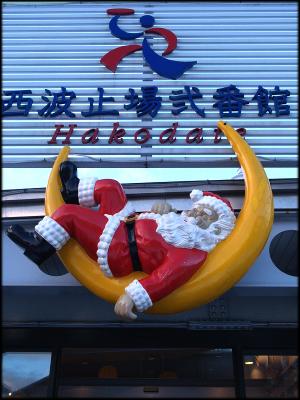
Christmas Eve evening is regarded as a romantic time in which boyfriends spend up to $1,000 on a night in a fancy hotel and dinner in a fancy French or Italian restuarant. One 29-year-old teacher told the New York Times, "For a guy, Christmas is the best chance to get a girl into his hands. No girl would turn down a restaurant dinner and a Christmas present. Of course, she might not want to go all the way to the hotel room." Japanese girls generally expect their suitors to spend $400 or $500 on a present like a Prada handbag, plus the dinner and perhaps the hotel room.
Reservations need to be made months in advance at popular restaurants and hotels. Disneyland and Universal Studios are also popular destinations. Reservations are needed there too.
Christmas Symbols in Japan
Santa Claus is known as "Santa Kurohsu." Children are sometimes taught he has eyes in the back of his head and can see what children are doing all year.
Japanese love Santa. They send more letters to Santa Clause’s home in Finnish Lapland than any other nationality and Santa's Village in Korvatunturi in Finland. Some get married there and other go there to get their marriage blessed.
Christmas songs are played year round. Department store play "Silent Night" in the middle of August. One of my Japanese friends loved to sing Rudolf the Red Nose Reindeer on spring hikes.
Japanese that have Christmas trees decorate them with small toys, dolls, paper ornaments, gold paper fans and lanterns, oragmi swans, wind chimes and Western-style ornaments.
History of Christmas in Japan
Kate Elwood wrote in the The Daily Yomiuri, “Anthropologist David Plath made a study of Christmas in Japan in 1963. He notes that as early as the 1870s Maruzen and Meidi-ya made use of Christmas decorations and sold Christmas goods, and by the 1930s it was sometimes listed in schools as one of the nenju gyoji yearly events. Following World War II, Christmas became more prominent, and Plath interestingly suggests it came to be associated with democracy. Gen. Douglas MacArthur proclaimed amnesty for war criminals on Christmas in 1949. Women and children could participate in Christmas celebrations while traditional bonenkai year-end parties were generally only for men. Additionally, the notions of an exchange of presents, and presents given to specific individuals rather than the whole household, appeared more democratic to some of Plath's informants than oseibo year-end gifts. Thus, Plath asserts, Christmas was enthusiastically adopted in Japan, but to serve a different purpose than in the United States. [Source: Kate Elwood, The Daily Yomiuri, November 15, 2011]
“And then there is the puzzling Japanese Christmas cake, which Plath notes does not seem to conform to any Christmas cake traditions in Europe or the United States. Folklorist Hideyo Konagaya suggests that the round cake is a type of parallel of the similarly round kagamimochi New Year's rice cakes, and further reflects on the circle as a symbol of wa, or unity. Additionally, the white icing and red strawberries correspond to the auspicious kohaku color combination used in many Japanese cultural expressions including the national flag. Konagaya avers: "The shape and color of the cake adhere to the symbolism of inherited Japanese ceremonial foods. On the other hand, the surface aspect of the cake provides a good medium to express new values and dreams of postwar Japanese society." A rectangular, dark brown Christmas fruitcake or Buche de Noel just wouldn't have the same cultural resonance.
Valentines Day in Japan
Valentine's Day, February 14, is a very big holiday in Japan. In an unusual twist Japanese women give chocolate to men, who return the gesture a month later by presenting white chocolates to women on "White Day."
To meet the demand for chocolates after the Kobe earthquake, which occurred about two weeks before Valentine's Day, a Kobe chocolate factory kept its production lines going by cooling the liquid chocolate into candy with frigid air blowing in from the windows rather than with water, which is how it is usually done. [Source: the Washington Post]
Before Valentines Day displays of chocolate are everywhere. Much of it is purchased by women as “giri choco” (“obligatory chocolate”). The idea of women giving chocolates to men on Valentines was reportedly hatched in the 1930s by a Kobe-based chocolate manufacturer.
Bon Festival of the Dead in Japan
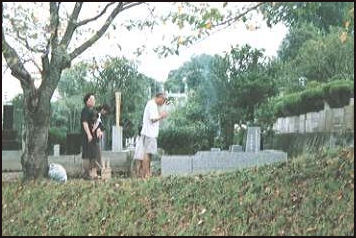 “ Obon” (Festival of the Dead) in August is when the souls of the dead are believed to return to their homes. Many people visit the graves of the ancestors and set up lanterns to guide the spirits of ancestral souls to and from their homes. Many Japanese seem to feel that more people die in August than any other time of the year. Sometimes there are tie-ins with events that remember the dead form the bombings of Hiroshima and Nagasaki and the ed of World War II which also occurred in August.
“ Obon” (Festival of the Dead) in August is when the souls of the dead are believed to return to their homes. Many people visit the graves of the ancestors and set up lanterns to guide the spirits of ancestral souls to and from their homes. Many Japanese seem to feel that more people die in August than any other time of the year. Sometimes there are tie-ins with events that remember the dead form the bombings of Hiroshima and Nagasaki and the ed of World War II which also occurred in August.
According to Japan's Foreign Ministry: Bon Bon or Obon is an annual observance to welcome and console the souls of one’s ancestors, who are thought to visit one’s home at this time of the year. It was traditionally observed around the middle of the seventh month according to the lunar calendar. At present it is observed in most places between July 13 and 15, though in some regions between August 13 and 15. On July 13, welcoming fires (“mukaebi”) are lit to greet the ancestors’ spirits. Then, on the sixteenth, seeing-off fires (“okuribi”) are lit as the ancestral souls return to the spirit world. During Bon, many companies and stores close for vacation and since people who work away from their native places often return there with their wives or husbands and children, transportation facilities, as during Golden Week, become very congested.
Bon is celebrated nationwide over the course of a week with feasting, the sprucing up of graves and prayers for the dead. Offerings of food are made to the deceased and sometimes special bon odori dances are performed at shrines and schools and lanterns are floated down rivers. Neighbors gather to dance informal bon odori dances. Taiko drums are often heard in the distance.
Obon is a time when urban families return to the hometowns to honor their ancestors. Many company employees are given a week off work along with a summer bonus. Roads are jammed with cars. Trains and planes are packed with people. For children it is happy time when the they get to go to their grandparent’s house and play outside in the countryside. For traveling adults it is often a stressful time when they do their best to keep a game face in front of their parents or in-laws.
The Japanese believe that during obon the dead return to earth and roam among the living. As bon approaches you find small bundles of straw at flower shops and supermarkets. On the first day of Bon. The dead are said to find their way back their families by the light of burning straw (“mukaebi” , or “welcoming fire”). On the last day, straw is burned again (“okuribi” or “send-off fire”) for the dead to return to the land of the dead. In some places red lanterns are left out to guide ghosts to their old homes and help them return to the spirit world.
Image Sources: All Ray Kinnane except Yoshino trees (JNTO) and cherry blossoms (amolife)
Text Sources: New York Times, Washington Post, Los Angeles Times, Daily Yomiuri, Times of London, Japan National Tourist Organization (JNTO), National Geographic, The New Yorker, Time, Newsweek, Reuters, AP, Lonely Planet Guides, Compton’s Encyclopedia and various books and other publications.
Last updated August 2012
